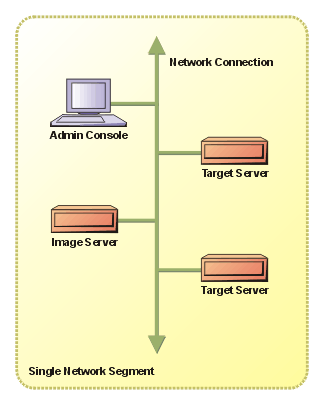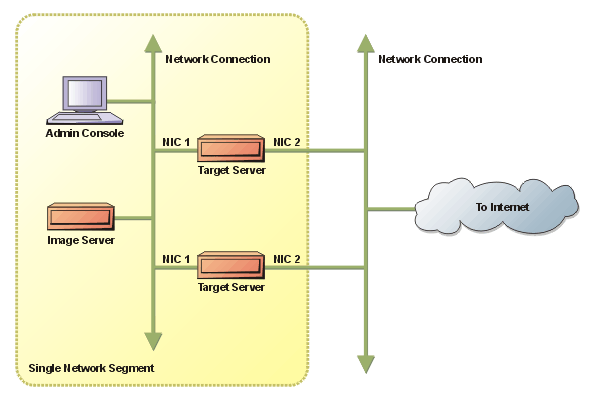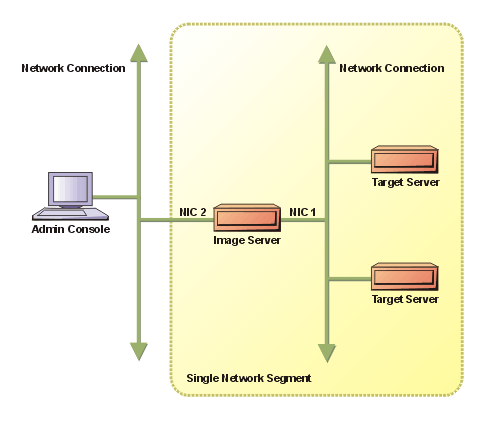| NOTICE: If you
change the IP address of the image server while using Remote Install, you
must reboot the image server to continue using Remote Install. Also, if storage resides on the image server for which you change the IP address, that storage will not function properly. If you must change the image server IP address, use the Settings→ Storage→ List→ Edit function to change the storage IP address to that of the image server. |
|
NOTE: Do not install Remote Install on a system that
is running the Microsoft® Remote Installation Service (RIS). RIS runs a TFTP server that prevents the Remote Install
DHCP server from responding to a PXE request from the target system.
It is acceptable for the two services to be installed on different systems on the same subnet. In this scenario, RIS answers the PXE request first, but ignores any other requests if its reply is ignored. Remote Install is then able to provide an address in response to the second PXE request. |
| NOTE: Remote Install provides an embedded Dell™ DHCP (DDHCP) server that uses the DHCP protocol to detect Dell target systems in the network. DDHCP detects Dell systems and validates whether or not the target system is a Dell system certified for use with Remote Install. Turn off all DHCP servers other than the Remote Install DHCP server. If this is not possible or desirable, see "Coexistence of Multiple DHCP and PXE Servers." |
You can connect the image server to the target systems in a variety of configurations. See "Single Network Segment," "Single Management Network Segment," "Admin Console and Image Server in Separate Subnets," and "Multiple Management Subnets" for the various network configurations that you can use.
One of the differences between a server and a desktop is that servers normally have multiple NICs. The multiple NICs can be in the image server or in the target systems. These NICs can be connected to different subnets as shown later in this section. Normally, only one NIC is connected to the management network. In this case no multiple NIC issue exists for the management network. If more than one NIC is connected to the management network, the image server responds to the NIC according to what is specified in the boot order. If more than one NIC in the image server is connected to the management network, the DHCP server in the image server listens to multiple NICs. It is strongly suggested that you connect only one NIC in the image server and one NIC in the target system to the management network.
| NOTE: Remote Install does not support capture, deploy or configure operations in a target system with load-sharing virtual NICs (also known as NIC teaming) enabled. |
| NOTE: If you want to use more than one NIC for Remote Install in a target system, configure both NICs with static IP addresses. |
This section covers the following topics:
DHCP, PXE, Switches, and Routers
DHCP and PXE in the Remote Install Environment
Coexistence of Multiple DHCP and PXE Servers
Remote Install includes an integrated DHCP/PXE server (or just "DHCP server"). DHCP, based on Internet RFC 2131, is often used to allocate IP addresses to systems. DHCP is fundamentally a LAN-based protocol because it depends on the ability of a client system to broadcast a request on its Ethernet network. A DHCP server must be able to "hear" the broadcast message from the client. While most Ethernet switches are transparent to broadcast messages (that is, most Ethernet switches allow broadcast messages to pass), most IP routers are not; routers are usually configured to block Ethernet broadcast messages. Without some assistance, a DHCP server can support client systems on a single physical LAN segment (subnet) only. The DHCP Relay Agent feature of most recently manufactured routers provides that assistance. Remote Install requires routers with the DHCP Relay Agent feature to manage multiple subnets.
PXE is an extension of DHCP and uses the DHCP protocol. PXE is used to load software on a remote system on the network and boot that system. Remote Install uses PXE to load and run the preoperating-system agent and discover new systems to manage on the network.
To manage multiple subnets, your Remote Install management network environment must meet the following requirements:
The Remote Install integrated PXE server responds only to PowerEdge™ systems. The Remote Install integrated DHCP server responds to all Dell PXE-booted servers, Dell Enterprise Solutions servers with the Dell OpenManage Kick-Start utility support, and ERA/MC, which is the remote access controller that is installed in the PowerEdge 1655MC system.
Remote Install uses two types of DHCP scopes:
The integrated DHCP server automatically detects the available IP addresses for the host system (image server) and listens on each for DHCP and PXE client systems. The server responds only to those systems that have a DHCP scope defined for their subnet.
The integrated DHCP/PXE server supports clients across routers. Most routers made in the last several years include the DHCP Relay Agent that enables DHCP servers to serve more than one physical LAN segment (subnet). The DHCP Relay Agent is a BOOTP relay agent specified in RFC1542. The DHCP Relay Agent forwards DHCP request messages (broadcast by DHCP client systems that want IP address assignments) to a specified DHCP server on some other IP network (LAN or subnet); it then forwards the replies from the DHCP server back to the client systems. With the cooperation of routers enabled with the DHCP Relay Agent, a single DHCP server can provide service to DHCP client systems on multiple LAN segments (subnets). You must configure a separate DHCP scope for each subnet.
When installing the agents on the target system using the Do Not Configure option, use the staticIP.txt file to enable the configuration to locate target systems across routers. The staticIP.txt file is created in the \dell\openmanage\netstart directory on the image server and is formatted as a list of IP addresses, such as 192.168.104.88, one IP address per line.
Interference between two DHCP servers is often, but not always, fatal to the operation of the overall network. Usually the two DHCP servers have different purposes, and interference between them causes at least one of the purposes to fail. The integrated DHCP server in Remote Install can be interfered with by another Dell DHCP server or any other DHCP server on the LAN. If network routers are enabled with the DHCP Relay Agent, it is possible for DHCP server interference to occur across subnets.
To avoid interference, your Remote Install management network environment must meet the following requirements:
This configuration is a simple network configuration in which the image server, target systems, and admin console are all in one subnet:

Setting up this network configuration requires:
In this configuration, multiple NICs exist for the target systems. Each target system has one NIC connected to the management network. Target systems might have other NICs connected to other subnets.

Setting up network configuration requires:
In this configuration, the admin console is not in the same subnet as the image server. The image server requires at least two NICs. One NIC is used to manage the deployment task. Another NIC is used to allow Web access to the image server from an admin console that is not in the management network.

Setting up this network configuration requires connecting the additional NIC of the image server to another subnet that is accessible to the admin console.
In this configuration, the image server is used to manage multiple subnets.

Setting up this network configuration requires:
| NOTE: More complicated network configurations such as multiple IPs for one NIC are not supported at this time. |